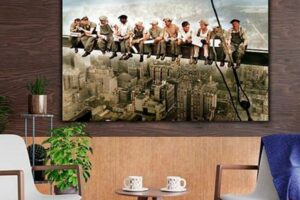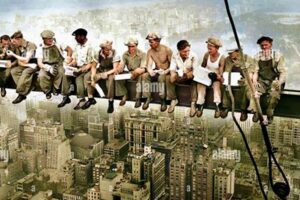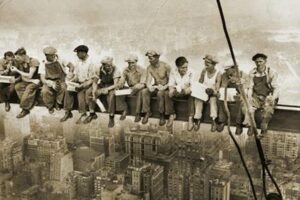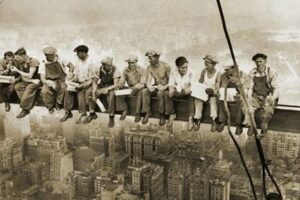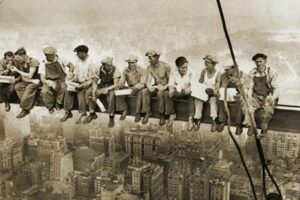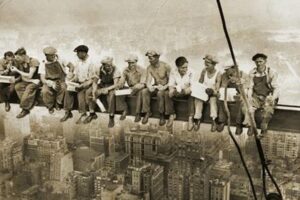The iconic “Lunch atop a Skyscraper” photograph, captured in 1932, has been the subject of much debate and fascination. Originally thought to depict a genuine moment of construction workers having lunch high above the streets of New York City, it was later revealed to be a staged publicity stunt. Despite its fabricated nature, the image remains a powerful representation of the era’s architectural achievements and the daring spirit of the workers who built the city’s skyscrapers.
The photograph’s enduring popularity can be attributed to its unique perspective and the sense of danger and excitement it conveys. It offers a glimpse into a world that is both awe-inspiring and perilous, and it captures the spirit of the American worker in the face of adversity. The image has been widely reproduced and referenced in popular culture, and it continues to fascinate viewers today.
While the “Lunch atop a Skyscraper” photograph may not be an accurate depiction of a real-life event, it nevertheless provides a valuable insight into the construction of New York City’s skyscrapers and the men who made it possible. It is a reminder of the ingenuity, determination, and courage of these workers, and it serves as a testament to the power of photography to capture and immortalize a moment in time.
1. Iconic
The “Lunch atop a Skyscraper” photograph has become an iconic symbol of New York City, instantly recognizable around the world. This is due to several factors:
- The image captures a unique moment in time. The photograph depicts construction workers eating lunch on a narrow beam, hundreds of feet above the ground. This is a visually striking and exciting image, and it provides a glimpse into a world that most people never see.
- The image is technically impressive. The photograph was taken in 1932, using a large-format camera. The photographer, Charles C. Ebbets, had to use a special technique to get all of the workers in focus. The resulting image is sharp and detailed, and it has a timeless quality.
- The image has been widely reproduced and referenced in popular culture. The “Lunch atop a Skyscraper” photograph has been featured in countless books, magazines, and movies. It has also been parodied and imitated many times. This widespread exposure has helped to make the image even more iconic.
The “Lunch atop a Skyscraper” photograph is a powerful and enduring image. It is a symbol of New York City, of American ingenuity, and of the human spirit. The photograph continues to fascinate and inspire viewers today, nearly a century after it was taken.
2. Staged
The “Lunch atop a Skyscraper” photograph was not a candid shot, but rather a carefully orchestrated publicity stunt. This fact has led some people to question the authenticity of the image and to dismiss it as a fake. However, the staged nature of the photograph does not diminish its historical or cultural significance.
The photograph was taken in 1932, during the construction of the Rockefeller Center in New York City. The photographer, Charles C. Ebbets, was hired by Rockefeller Center Inc. to take publicity photos of the construction project. Ebbets staged the “Lunch atop a Skyscraper” photograph in order to create a dramatic and iconic image that would promote the Rockefeller Center.
The photograph was a huge success, and it has become one of the most iconic images of New York City. It has been reproduced countless times in books, magazines, and movies. The photograph has also been parodied and imitated many times.
The staged nature of the “Lunch atop a Skyscraper” photograph does not make it any less iconic or significant. The photograph is a powerful symbol of the construction of New York City and of the American worker. It is a reminder of the ingenuity, determination, and courage of the men who built the city’s skyscrapers.
3. Workers
The fact that the men in the “Lunch atop a Skyscraper” photograph were actual construction workers, not actors, is a significant detail that adds to the image’s authenticity and historical value. It is a reminder that the construction of New York City’s skyscrapers was a dangerous and demanding job, and that the men who built these iconic structures were skilled and courageous workers.
The use of actual construction workers in the photograph also helps to dispel the myth that the image was staged or fake. While the photograph was indeed carefully orchestrated by photographer Charles C. Ebbets, the workers were not actors posing for the camera. They were real-life construction workers who were taking a break from their work to eat lunch.
The presence of actual construction workers in the photograph also adds a sense of realism and immediacy to the image. It is a reminder that the construction of New York City’s skyscrapers was a real event, and that the men who built these structures were real people.
In conclusion, the fact that the men in the “Lunch atop a Skyscraper” photograph were actual construction workers, not actors, is a significant detail that adds to the image’s authenticity, historical value, and sense of realism. It is a reminder that the construction of New York City’s skyscrapers was a dangerous and demanding job, and that the men who built these iconic structures were skilled and courageous workers.
4. Danger
The danger faced by the workers in the “Lunch atop a Skyscraper” photograph is a key component of the image’s overall impact. The men are perched on a narrow beam, hundreds of feet above the ground, with no safety harnesses or other protective gear. This precarious position creates a sense of suspense and excitement, and it underscores the bravery and skill of the workers.
The danger faced by the workers is also a reminder of the real risks involved in the construction of New York City’s skyscrapers. These men were working at great heights, in all weather conditions, and with heavy machinery. Their job was dangerous, and many workers were injured or killed during the construction of the city’s skyscrapers.
The “Lunch atop a Skyscraper” photograph is a powerful reminder of the dangers faced by construction workers, and it is a testament to their courage and skill. The image is also a reminder of the importance of safety in the workplace, and it serves as a reminder that we should never take for granted the safety of our workers.
5. Lunch
In the iconic “Lunch atop a Skyscraper” photograph, the workers are depicted eating lunch, a seemingly mundane activity in an extraordinary setting. This juxtaposition creates a powerful and memorable image that highlights the dangerous and demanding working conditions faced by construction workers in the early 20th century.
The workers in the photograph are perched on a narrow beam, hundreds of feet above the ground, with no safety harnesses or other protective gear. They are eating lunch, a seemingly mundane activity, in an extraordinarily dangerous setting. This contrast underscores the bravery and skill of the workers, who were responsible for building some of the world’s tallest skyscrapers.
The “Lunch atop a Skyscraper” photograph is a powerful reminder of the importance of safety in the workplace. It is also a testament to the courage and skill of the workers who built New York City’s skyscrapers.
6. Symbol
The “Lunch atop a Skyscraper” photograph has become a powerful symbol of the American worker and the construction of New York City’s skyscrapers. This is due to several factors:
- The photograph captures a unique moment in time. The image depicts construction workers eating lunch on a narrow beam, hundreds of feet above the ground. This is a visually striking and exciting image, and it provides a glimpse into a world that most people never see.
- The photograph is technically impressive. The photograph was taken in 1932, using a large-format camera. The photographer, Charles C. Ebbets, had to use a special technique to get all of the workers in focus. The resulting image is sharp and detailed, and it has a timeless quality.
- The photograph has been widely reproduced and referenced in popular culture. The “Lunch atop a Skyscraper” photograph has been featured in countless books, magazines, and movies. It has also been parodied and imitated many times. This widespread exposure has helped to make the image even more iconic.
The “Lunch atop a Skyscraper” photograph has become a symbol of the American worker and the construction of New York City’s skyscrapers because it captures a unique moment in time, is technically impressive, and has been widely reproduced and referenced in popular culture. The image is a reminder of the ingenuity, determination, and courage of the men who built the city’s skyscrapers.
The “Lunch atop a Skyscraper” photograph is also a reminder of the importance of safety in the workplace. The workers in the photograph are perched on a narrow beam, hundreds of feet above the ground, with no safety harnesses or other protective gear. This is a dangerous situation, and it is a reminder that construction workers face many risks on the job.
The “Lunch atop a Skyscraper” photograph is a powerful and iconic image. It is a symbol of the American worker, the construction of New York City’s skyscrapers, and the importance of safety in the workplace.
7. History
The iconic “Lunch atop a Skyscraper” photograph provides a unique glimpse into the past and the working conditions of construction workers in the early 20th century. The image depicts eleven construction workers eating lunch on a narrow beam, hundreds of feet above the ground, with no safety harnesses or other protective gear. This image is a powerful reminder of the dangers and hardships faced by construction workers during this time period.
- Dangerous working conditions: The “Lunch atop a Skyscraper” photograph illustrates the dangerous working conditions that construction workers faced in the early 20th century. The workers in the photograph are perched on a narrow beam, hundreds of feet above the ground, with no safety harnesses or other protective gear. This was a common occurrence for construction workers at the time, and many workers were injured or killed on the job.
- Lack of safety regulations: The lack of safety regulations in the early 20th century contributed to the dangerous working conditions faced by construction workers. There were no OSHA regulations or other safety standards in place to protect workers from hazards on the job. As a result, construction workers were often exposed to dangerous conditions, such as working at great heights without safety harnesses or working with heavy machinery without proper training.
- Importance of safety: The “Lunch atop a Skyscraper” photograph serves as a reminder of the importance of safety in the workplace. The image shows the dangers that construction workers faced in the early 20th century, and it highlights the need for safety regulations and training to protect workers from injury and death.
The “Lunch atop a Skyscraper” photograph is a powerful reminder of the dangers and hardships faced by construction workers in the early 20th century. The image serves as a reminder of the importance of safety in the workplace and the need for safety regulations and training to protect workers from injury and death.
8. Legacy
The enduring popularity and fascination with the “Lunch atop a Skyscraper” photograph can be attributed to several key factors:
- Iconic imagery: The photograph’s striking composition and powerful visual elements make it an instantly recognizable and memorable image. The juxtaposition of the workers’ precarious perch hundreds of feet above the ground with their casual lunchtime activity creates a sense of tension and drama that draws viewers in.
- Historical significance: The photograph captures a unique moment in the construction of New York City’s skyscrapers, a period of rapid urbanization and architectural innovation. It serves as a reminder of the skill, bravery, and determination of the workers who built these iconic structures.
- Cultural relevance: The “Lunch atop a Skyscraper” photograph has become a symbol of American ingenuity and ambition, and it continues to be referenced and reinterpreted in popular culture. It has been featured in countless works of art, literature, and film, solidifying its place in the collective imagination.
- Emotional resonance: The photograph evokes a range of emotions in viewers, from awe and wonder to a sense of vertigo and danger. It prompts us to reflect on the human experience, the fragility of life, and the indomitable spirit of those who dare to reach for the sky.
The enduring legacy of the “Lunch atop a Skyscraper” photograph lies in its ability to transcend its historical context and continue to inspire and fascinate viewers today. It remains a powerful reminder of the human spirit, the importance of perseverance, and the beauty and danger inherent in the pursuit of progress.
FAQs about “Lunch atop a Skyscraper”
The iconic “Lunch atop a Skyscraper” photograph has sparked curiosity and debate since its inception. Here are answers to some frequently asked questions surrounding this captivating image:
Question 1: Is the “Lunch atop a Skyscraper” photograph real or staged?
While the image has been the subject of speculation, it is widely accepted to be a staged publicity stunt. The photograph was carefully orchestrated by photographer Charles C. Ebbets to promote the construction of the Rockefeller Center in New York City.
Question 2: Who are the men in the photograph?
The eleven men depicted in the photograph were actual construction workers involved in the Rockefeller Center project. They were identified as (from left to right): John Coleman, Joseph Curtis, Patrick Glynn, Edward Hynes, Jack Lambert, Walter Lichtenstein, Steve Mucci, Francis Michael Rafferty, Charles Smith, Joseph Wendt, and Ben Wolfe.
Question 3: Were the workers in any real danger during the photoshoot?
Although the photograph conveys a sense of danger, the workers were not in immediate peril. Safety precautions were taken, including the use of a safety net below the beam where they were seated. However, the height and lack of safety harnesses would be considered hazardous by today’s standards.
Question 4: What is the significance of the “Lunch atop a Skyscraper” photograph?
The photograph has become an enduring symbol of American ingenuity, ambition, and the construction boom that shaped the New York City skyline. It captures the spirit of the workers who risked their lives to build some of the world’s tallest skyscrapers.
Question 5: Has the “Lunch atop a Skyscraper” photograph been referenced in popular culture?
Yes, the photograph has been widely reproduced and referenced in various forms of popular culture, including movies, television shows, literature, and even postage stamps. Its iconic status has made it a recognizable symbol that evokes the era of skyscraper construction.
Question 6: What lessons can we learn from the “Lunch atop a Skyscraper” photograph?
The photograph serves as a reminder of the importance of teamwork, perseverance, and safety in the face of challenges. It also highlights the contributions of construction workers and the often-overlooked dangers they face in building the structures that shape our cities.
In conclusion, the “Lunch atop a Skyscraper” photograph remains a captivating and evocative image that provides insights into the history, culture, and human spirit behind the construction of some of the world’s most iconic skyscrapers.
Explore more: Insights into the Construction and Legacy of New York City’s Skyscrapers
Essential Tips for Understanding “Lunch atop a Skyscraper”
The iconic “Lunch atop a Skyscraper” photograph has captivated audiences worldwide, sparking curiosity and debate. To delve deeper into the significance and context of this image, consider these essential tips:
Tip 1: Understand the Historical Context:
The photograph was captured during the construction of Rockefeller Center in New York City in 1932. This period marked a pivotal era in skyscraper construction, characterized by technological advancements and architectural innovation.
Tip 2: Recognize the Staged Nature:
Contrary to popular belief, the “Lunch atop a Skyscraper” photograph was not a candid shot. It was meticulously staged by photographer Charles C. Ebbets to promote the Rockefeller Center project. This realization adds a layer of complexity to the image’s interpretation.
Tip 3: Identify the Workers:
The eleven men featured in the photograph were actual construction workers involved in the Rockefeller Center construction. They were identified and their stories provide insights into the lives and experiences of those who built the city’s iconic skyline.
Tip 4: Examine Safety Concerns:
While the photograph exudes a sense of danger, the workers were not in immediate peril. Safety precautions were implemented, including the use of a safety net below the beam. Nonetheless, the image serves as a reminder of the inherent risks associated with skyscraper construction.
Tip 5: Analyze the Symbolism:
Beyond its historical significance, the “Lunch atop a Skyscraper” photograph has become a symbol of American ingenuity, ambition, and the spirit of construction workers. It captures the essence of human endeavor and the pursuit of progress.
Tip 6: Explore Cultural Impact:
The photograph has transcended its original context and has been widely referenced in popular culture, including movies, television shows, and literature. Its iconic status has made it a recognizable symbol of the era of skyscraper construction.
Tip 7: Draw Parallels to Modern Construction:
While construction techniques and safety regulations have evolved since the 1930s, the “Lunch atop a Skyscraper” photograph remains relevant. It highlights the ongoing challenges and achievements in modern skyscraper construction, showcasing the skill and determination of construction workers.
Summary:
By understanding the historical context, staged nature, identification of workers, safety concerns, symbolism, cultural impact, and parallels to modern construction, we gain a comprehensive appreciation of the “Lunch atop a Skyscraper” photograph. It serves as a valuable lens through which to explore the history, culture, and human spirit behind the construction of some of the world’s tallest skyscrapers.
Conclusion
The exploration of “Lunch atop a Skyscraper: Fake but Iconic” has illuminated the complexities surrounding this captivating photograph. Initially perceived as a genuine depiction of construction workers having lunch high above the streets of New York City, its staged nature has sparked discussions about authenticity and historical interpretation.
Despite its carefully orchestrated nature, the image remains a powerful symbol of American ingenuity, ambition, and the spirit of construction workers. It serves as a testament to the skill, determination, and courage of those who built the city’s iconic skyscrapers, even if the specific moment captured was not spontaneous. The photograph continues to inspire and fascinate viewers today, reminding us of the human endeavor and the pursuit of progress.


